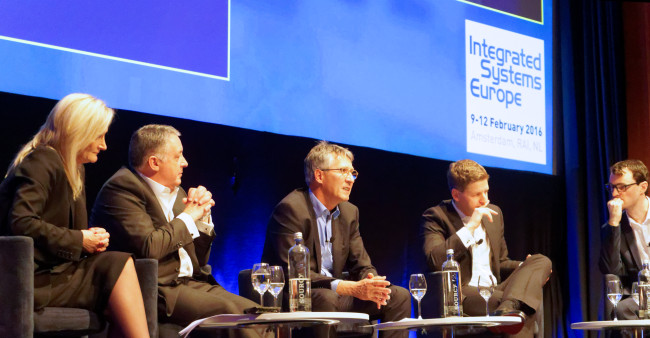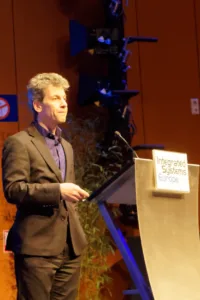On the evening before the start of the main event, ISE kicked off with a panel session entitled “IT in AV: Interconnecting for Smart Solutions”. There were five panelists and the session was moderated by David Rowan of Wired (UK) magazine.
Mike Blackburn, the man behind ISE, started by saying that this year sees the extension of ISE to four days with an expected 60K visitors (and that number was beaten). He said that there is now convergence or a “collision” of IT and A/V. Blackburn believes that ISE is uniquely positioned to “move the debate forward”.
Cedia and Infocomm are organising training and personal development sessions during the show. 150 sessions will be presented in the four “theatres” on the show floor and there was also a “Digital Signage Summit” in the theatres. There are sessions on A/V and sport and also a business conference on mergers and acqusitions in the business.
Rowan started his talk by saying that he is not a futurist, but he goes around the world talking to companies that are trying to develop the future and also to the VCs who take the high risk decisions to fund these start-ups. The big topic for him at the moment is “sensorisation”. He mentioned drones including eHang, which is making drones for transporting people. He also gave a video demo of DJI’s gimbal-mounted camera on a drone and the reason that GoPro’s share price is falling, in his view. However, we’re still at the beginning of the process of sensorisation.
He talked about a kitchen robot that can replicate the exact movements of famous chefs, about autonomous cars and showed an iron ore processing site where the trucks and systems are fully automated. But this process of automation is an exponential “Moore’s Law” curve.
Screens are now ubiquitous – he referred several times to data that showed that digital media consumption had increased from 2.7 hours per day in 2008 to 5.6 hours per day. He gave lots and lots of examples of technology innovation including a toothbrush that senses usage and sends data back. Another product is the Sproutling – a sophisticated baby monitor that ships in March….
 Rowan said that a lot of developments are “quirky” – he described the environment as, sometimes, an internet of stupid things – he mentioned a Chinese hairdressing salon that is apparently called “could not connect to translator service”!
Rowan said that a lot of developments are “quirky” – he described the environment as, sometimes, an internet of stupid things – he mentioned a Chinese hairdressing salon that is apparently called “could not connect to translator service”!
This year’s big thing is VR, Rowan said, and $800 million has been raised by Magic Leap which has given little information about its technology, at least, it has given information to investors. Check out the video at http://tinyurl.com/qj9697t to get an idea of what Magic Leap is doing.
Affectiva is an emotion tracker and Emotient is also working in this space ( and has just been bought by Apple). Rowan talked about “Churchix” – which uses face recognition in churches so that church authorities know who is there. Deepmind, a UK company, was sold for £400 million – for true artificial intelligence, he said.
Networking everything releases a lot of potential but also provides a lot of “hackability” and security
Everthing becomes exponential, Rowan said.
Panel Discussion – The Convergence of IT & A/V
 Barnett (CDEC), Morrison (Harmon), Eberhardt (NEC), Grady (Google) and Wagstaff (Context). Image: Meko Ltd
Barnett (CDEC), Morrison (Harmon), Eberhardt (NEC), Grady (Google) and Wagstaff (Context). Image: Meko Ltd
The panel introduced themselves:
- Mark Grady is from Google and is involved with Chrome and Android. Young people are very familiar with technology, but often find in B2B A/V settings such as video conferencing that it’s not as intuitive as consumer products – he is working on Chromebox for meetings (behind Google’s VC experience). Digital signage is an interesting application for Grady. He said that with a ChromeBit it costs just €90 to run an HTML website plugged into HDMI using the device.
- Bernd Eberhardt has been at NEC Display Solutions since 1993 and he is Managing Director of the European company. He said that NEC is “display agnostic” – its business is currently built around “three L’s” – LED, LCD and laser. He supports the idea of sensorisation and NEC has been working on sensor middleware (the Leaf Engine – Man. Ed.) for several years and has done research projects as part of this in Europe.
- Toni Barnett is from CDEC (an A/V reseller in the UK) which tends to specialise in education including touch, LEDs etc The business has been going for 16 years and has 40 staff. Barnett gave a pre-prepared pitch about her company.
- Jonathan Wagstaff is from data company, Context, and he said that there is good news for displays and network-related sales. There is growth in projection, interactive whiteboards and interactive displays. He pointed out that there is a huge amount of computing power needed to drive products in VR such as the Oculus Rift and he said that this would also mean a “hit to resolution” if systems can’t cope.
- Kevin Morrison is from Harman Professional, part of the $6.5 billion Harman company and the firm sees a lot of potential for helping audio to work as customers move between different spaces and areas. The company has 26,000 engineers globally and has a very strong position in automotive audio.
Rowan asked if anybody on the panel had worked on any projects that seemed to be A/V but ended up being an IT or networking project? Morrison said that his firm was called into a company that wanted to have a “green” building – it turned out that you can’t “bolt it on”. You can build smart buildings, he said, but you have to be involved from the architect onwards.
Rowan asked if embedding technology meant a fear of redundancy? Eberhardt said that NEC worked with a Japanese retailer on a global digital signage project. Everything was done through an IT company to take advantage of its relationships, but Eberhardt said that eventually, a lot of local A/V knowledge and experience was needed to get systems installed and working effectively. There are a lot of local regulations and adaptations you have to take account of when you run digital signage projects around the world.
Grady said that it’s important to set expectations accurately and also to get good feedback on usage and other metrics.
In response to a question, Wagstaff said that there is a lot of spending going on from companies that are trying to ensure “upgrade proofing”.
Eberhadt said that it can often be hard to work out who the real decision maker is in large projects. Sometimes you have to deal with marketing, sometimes IT, sometimes A/V and also corporate management. Morrison said that most project decisions are “concensus-based”.
Rowan asked about the contact with those responsible for security and the concensus was that IT professionals tended to look at the security aspects, although after the impact of security issues on companies, general management, right up to the CEO, may also be involved.
Rowan asked about the future of events and meetings. Wagstaff said that he keeps reading that “the conference room is dead” and its all about “collaboration spaces”. He also said that it is interesting that companies such as Google are disrupting the conferencing market, rather than traditional suppliers.
Grady said that Google, internally, has 12,000 rooms connected to video conferencing. The availability of the technology is changing how VC is being used – sometimes people leave it permanently connected to enhance collaboration. Morrison said that there are new ways of using collaboration technologies – it’s now much more based around individual or shared desks or workstations than special rooms or facilities.
In response to a question about the importance of new technology, Barnett said that VR might be like 3D – there was a lot of interest, but then it went away. Eberhardt said that in the B2B market, people buy from people and human interaction remains critical. Wagstaff said, and there was concensus, that VR will be consumer-led, rather than by B2B.
There was another question about whether there was sense in fusing live and sport events and cinema? Eberhardt said that NEC is a leader in cinema technology and there are lots of new opportunities both indoor and outdoor areas. There are big opportunities in digitising the lobby, but cinemas are conservative and often don’t change their practices. (BR)

